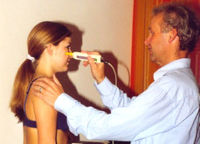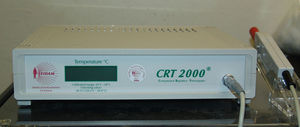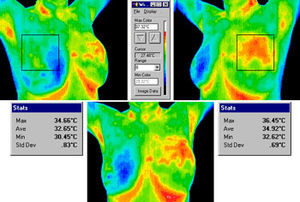Différences entre les versions de « Thermographie de régulation »
| Ligne 24 : | Ligne 24 : | ||
* http://www.itwm.fraunhofer.de/de/as__asprojects__thermography/thermography/ | * http://www.itwm.fraunhofer.de/de/as__asprojects__thermography/thermography/ | ||
* http://www.skeptics.com.au/theskeptic/2002/2_breastscreen.pdf | * http://www.skeptics.com.au/theskeptic/2002/2_breastscreen.pdf | ||
| − | * https://www.santeweb.ch/Sujets_Prioritaires/Cancer_du_sein/Actualites/Cancer_du_sein_Mise_en_garde_concernant_la_thermographie.html Cancer du sein : Mise en garde concernant la thermographie. De (Dr méd. Daniel Desalmand)<br>Les adeptes de la thermographie la considèrent comme une alternative rapide et moins radioactive que la mammographie. Mais, l’agence américaine „Food and Drug Administration FDA“ avertit qu’il n’existe pas d’études cliniques ayant prouvé ces suppositions.<br><br>La thermographie part du principe que le cancer se manifeste par une augmentation du métabolisme et de la perfusion sanguine, ainsi que par un réchauffement prononcé.<br>Les supporters de la thermographie pensent même que les tumeurs peuvent ainsi être découvertes plus rapidement qu’avec une mammographie. Un autre avantage serait qu’aucun contact physique n’est nécessaire lors de la thermographie, ce qui est agréable pour la femme. De même, cette méthode ne cause pas d’irradiations, comme c’est le cas lors d’une mammographie.<br><br>L’agence d’inspection américaine „Food and Drug Administration FDA“ indique n’avoir trouvé aucune étude clinique prouvant que la thermographie permet de découvrir un cancer du sein plus rapidement. La FDA redoute même le contraire: les hypothèses des adeptes de la thermographie ont empêché des femmes d’effectuer une mammographie, si bien que des tumeurs n’ont été découvertes chez elles qu’à un stade avancé, voir même trop tardivement. | + | * https://www.santeweb.ch/Sujets_Prioritaires/Cancer_du_sein/Actualites/Cancer_du_sein_Mise_en_garde_concernant_la_thermographie.html Cancer du sein : Mise en garde concernant la thermographie. De (Dr méd. Daniel Desalmand)<br>Les adeptes de la thermographie la considèrent comme une alternative rapide et moins radioactive que la mammographie. Mais, l’agence américaine „Food and Drug Administration FDA“ avertit qu’il n’existe pas d’études cliniques ayant prouvé ces suppositions.<br><br>La thermographie part du principe que le cancer se manifeste par une augmentation du métabolisme et de la perfusion sanguine, ainsi que par un réchauffement prononcé.<br>Les supporters de la thermographie pensent même que les tumeurs peuvent ainsi être découvertes plus rapidement qu’avec une mammographie. Un autre avantage serait qu’aucun contact physique n’est nécessaire lors de la thermographie, ce qui est agréable pour la femme. De même, cette méthode ne cause pas d’irradiations, comme c’est le cas lors d’une mammographie.<br><br>L’agence d’inspection américaine „Food and Drug Administration FDA“ indique n’avoir trouvé aucune étude clinique prouvant que la thermographie permet de découvrir un cancer du sein plus rapidement. La FDA redoute même le contraire: les hypothèses des adeptes de la thermographie ont empêché des femmes d’effectuer une mammographie, si bien que des tumeurs n’ont été découvertes chez elles qu’à un stade avancé, voir même trop tardivement.<br><br> |
| + | * https://www.fda.gov/medical-devices/safety-communications/fda-warns-thermography-should-not-be-used-place-mammography-detect-diagnose-or-screen-breast-cancer FDA Warns Thermography Should Not Be Used in Place of Mammography to Detect, Diagnose, or Screen for Breast Cancer: FDA Safety Communication Date Issued February 25, 2019<br><br>Product<br><br>Thermography is a noninvasive tool that uses an infrared camera to produce images (thermograms) that show the patterns of heat and blood flow on or near the surface of the body. Thermography devices, also known as digital infrared imaging devices, have been cleared for marketing by the FDA only for use with another screening or diagnostic test like mammography, not for use as a standalone diagnostic tool.<br><br>Purpose<br><br>The FDA is alerting women, health care providers, and people getting breast cancer screening, that thermography is not an effective alternative to mammography and should not be used in place of mammography for breast cancer screening or diagnosis.<br><br>There is no valid scientific data to demonstrate that thermography devices, when used on their own or with another diagnostic test, are an effective screening tool for any medical condition including the early detection of breast cancer or other diseases and health conditions.<br><br>Mammography (taking X-ray pictures of the breasts) is the most effective breast cancer screening method and the only method proven to increase the chance of survival through earlier detection.<br><br>Summary of Problem and Scope<br><br>The FDA is aware that health spas, homeopathic clinics, mobile health units, and other health care facilities are using thermography inappropriately as a standalone tool for breast cancer screening or diagnosis.<br>The FDA has received reports that these types of facilities provide false information that can mislead patients into believing that thermography is an alternative or better option than mammography. Some facilities make inaccurate, unsupported, and misleading claims, such as thermography can find breast cancer years before it would be detected through other methods or thermography improves detection of cancer in dense breasts.<br><br>None of these claims are true or have any valid scientific evidence to support them. In addition, the Society for Breast ImagingExternal Link Disclaimer notes a lack of evidence that thermography has any effective role in breast cancer screening. Mammography is the most safe and effective tool for screening and diagnosis of breast cancer, and the only method proven to increase the chance of survival through earlier detection.<br><br>The FDA is concerned that people will believe the misleading claims about thermography and not get mammograms to screen for breast cancer. People who choose thermography instead of mammograms may miss the chance to detect cancer at its earliest and most treatable stages. The agency is taking steps to stop the false advertising of thermography—see the FDA Actions section below for more information.<br><br>Recommendations for People Getting Breast Cancer Screening<br><br>Be aware that thermography is not a substitute for regular mammograms and should not be used in place of mammography for breast cancer screening or diagnosis. [...] | ||
{{OtherLang|ge=Regulationsthermographie}} | {{OtherLang|ge=Regulationsthermographie}} | ||
Version actuelle datée du 23 avril 2020 à 17:21
La thermographie de régulation (RTG, thermographie de régulation selon Arno Rost, Computer Regulations Thermographie CRT, Computerized Regulation Thermography) est une méthode de diagnostic non validée qui peut être considérée comme une utilisation de la thermographie connue et qu'on trouve exclusivement dans le domaine médical alternatif de la médecine dite de régulation. Dans cette méthode, la température de la surface du corps est mesurée avant et après une phase de refroidissement induite afin d'obtenir des indices sur la capacité de la personne testée à maintenir la température du corps constante (thermorégulation) .
La méthode est basée sur l'hypothèse que la thermorégulation supposée pathologique et s'écartant de la norme est adaptée à la détection des maladies.
La méthode inventée par le dentiste et homéopathe Arno Rost (21 septembre 1919 - 5 juillet 2005) et son épouse, la doctoresse Jutta Rost, ainsi que d'autres méthodes, sont développées par une association appelée la Société allemande de thermographie et de médecine de régulation (Deutsche Gesellschaft für Thermographie und Regulationsmedizin e.V., en abrégé DGTR e.V.) à Waldbronn. Une société EIDAM Medizin-Technologie GmbH fabrique les produits correspondants. La littérature scientifique sur cette méthode est très rare et il n'existe aucune étude pouvant être évaluée.
La méthode
En thermographie de régulation, la température de la surface du corps ou le rayonnement thermique de la surface de la peau du corps humain sont mesurés avant et après un refroidissement contrôlé. Selon les spécifications de la DGTR, deux variantes devraient être disponibles :
- La thermographie de contact selon Arno Rost (thermographie de régulation de contact) : Certains points de la surface de la peau sont mesurés avec un capteur de chaleur électronique. Un enregistreur connecté enregistre les valeurs déterminées. La chaleur est mesurée en deux passages avec le corps déshabillé, une fois avant et une seconde fois après une période de refroidissement de dix minutes du patient à température ambiante (19-21°C). Cette méthode est destinée à aider à détecter les troubles et les maladies des organes.
- Thermographie de régulation-infrarouge (IRI). En thermographie de régulation-infrarouge, la répartition de la température de la peau est enregistrée à l'aide d'une caméra thermique infrarouge. Ici encore, deux fois : une fois avant et une fois après un temps de refroidissement de 10 minutes. Cette méthode de thermographie-infrarouge serait particulièrement adaptée aux examens médicaux préventifs et à la détection du cancer du sein, car selon les partisans de cette méthode, les changements de température visibles précèdent le cancer de plusieurs années et seraient détectables plus tôt que les changements de l'image échographique ou de l'image mammographique.
Littérature
- Oepen I (1992): Kritische Bewertung unkonventioneller diagnostischer und therapeutischer Methoden in der Zahnheilkunde, Journal of Orofacial Orthopedics/Fortschritte der Kieferorthopädie 53(4), 239-246. DOI 0.1007/BF02327641
- Hentschel C, Lindner M, Ernst E (1994): Contact regulation thermography: a useful diagnostic procedure? Acta Med Austriaca 21(5):121-4
- R Berz - EP Patent 1212977 (2002)
Liens externes
- http://www.itwm.fraunhofer.de/de/as__asprojects__thermography/thermography/
- http://www.skeptics.com.au/theskeptic/2002/2_breastscreen.pdf
- https://www.santeweb.ch/Sujets_Prioritaires/Cancer_du_sein/Actualites/Cancer_du_sein_Mise_en_garde_concernant_la_thermographie.html Cancer du sein : Mise en garde concernant la thermographie. De (Dr méd. Daniel Desalmand)
Les adeptes de la thermographie la considèrent comme une alternative rapide et moins radioactive que la mammographie. Mais, l’agence américaine „Food and Drug Administration FDA“ avertit qu’il n’existe pas d’études cliniques ayant prouvé ces suppositions.
La thermographie part du principe que le cancer se manifeste par une augmentation du métabolisme et de la perfusion sanguine, ainsi que par un réchauffement prononcé.
Les supporters de la thermographie pensent même que les tumeurs peuvent ainsi être découvertes plus rapidement qu’avec une mammographie. Un autre avantage serait qu’aucun contact physique n’est nécessaire lors de la thermographie, ce qui est agréable pour la femme. De même, cette méthode ne cause pas d’irradiations, comme c’est le cas lors d’une mammographie.
L’agence d’inspection américaine „Food and Drug Administration FDA“ indique n’avoir trouvé aucune étude clinique prouvant que la thermographie permet de découvrir un cancer du sein plus rapidement. La FDA redoute même le contraire: les hypothèses des adeptes de la thermographie ont empêché des femmes d’effectuer une mammographie, si bien que des tumeurs n’ont été découvertes chez elles qu’à un stade avancé, voir même trop tardivement. - https://www.fda.gov/medical-devices/safety-communications/fda-warns-thermography-should-not-be-used-place-mammography-detect-diagnose-or-screen-breast-cancer FDA Warns Thermography Should Not Be Used in Place of Mammography to Detect, Diagnose, or Screen for Breast Cancer: FDA Safety Communication Date Issued February 25, 2019
Product
Thermography is a noninvasive tool that uses an infrared camera to produce images (thermograms) that show the patterns of heat and blood flow on or near the surface of the body. Thermography devices, also known as digital infrared imaging devices, have been cleared for marketing by the FDA only for use with another screening or diagnostic test like mammography, not for use as a standalone diagnostic tool.
Purpose
The FDA is alerting women, health care providers, and people getting breast cancer screening, that thermography is not an effective alternative to mammography and should not be used in place of mammography for breast cancer screening or diagnosis.
There is no valid scientific data to demonstrate that thermography devices, when used on their own or with another diagnostic test, are an effective screening tool for any medical condition including the early detection of breast cancer or other diseases and health conditions.
Mammography (taking X-ray pictures of the breasts) is the most effective breast cancer screening method and the only method proven to increase the chance of survival through earlier detection.
Summary of Problem and Scope
The FDA is aware that health spas, homeopathic clinics, mobile health units, and other health care facilities are using thermography inappropriately as a standalone tool for breast cancer screening or diagnosis.
The FDA has received reports that these types of facilities provide false information that can mislead patients into believing that thermography is an alternative or better option than mammography. Some facilities make inaccurate, unsupported, and misleading claims, such as thermography can find breast cancer years before it would be detected through other methods or thermography improves detection of cancer in dense breasts.
None of these claims are true or have any valid scientific evidence to support them. In addition, the Society for Breast ImagingExternal Link Disclaimer notes a lack of evidence that thermography has any effective role in breast cancer screening. Mammography is the most safe and effective tool for screening and diagnosis of breast cancer, and the only method proven to increase the chance of survival through earlier detection.
The FDA is concerned that people will believe the misleading claims about thermography and not get mammograms to screen for breast cancer. People who choose thermography instead of mammograms may miss the chance to detect cancer at its earliest and most treatable stages. The agency is taking steps to stop the false advertising of thermography—see the FDA Actions section below for more information.
Recommendations for People Getting Breast Cancer Screening
Be aware that thermography is not a substitute for regular mammograms and should not be used in place of mammography for breast cancer screening or diagnosis. [...]
Article de Psiram dans d'autres langues
- Deutsch: Regulationsthermographie



